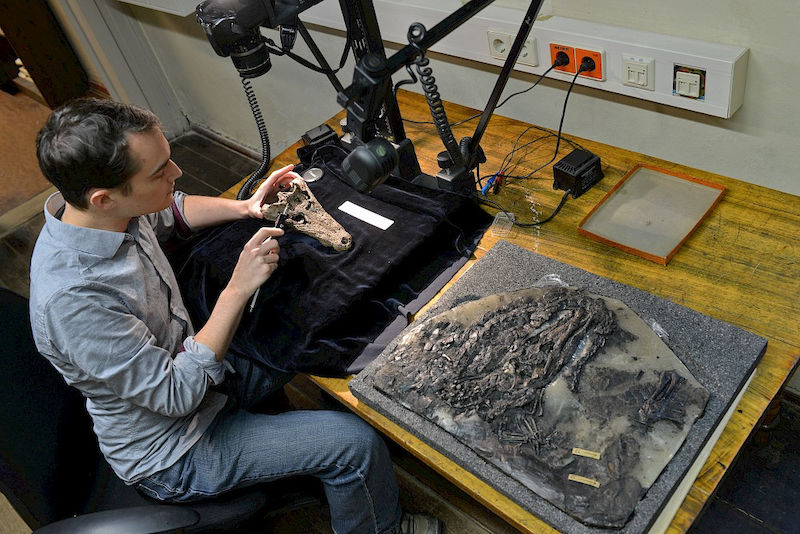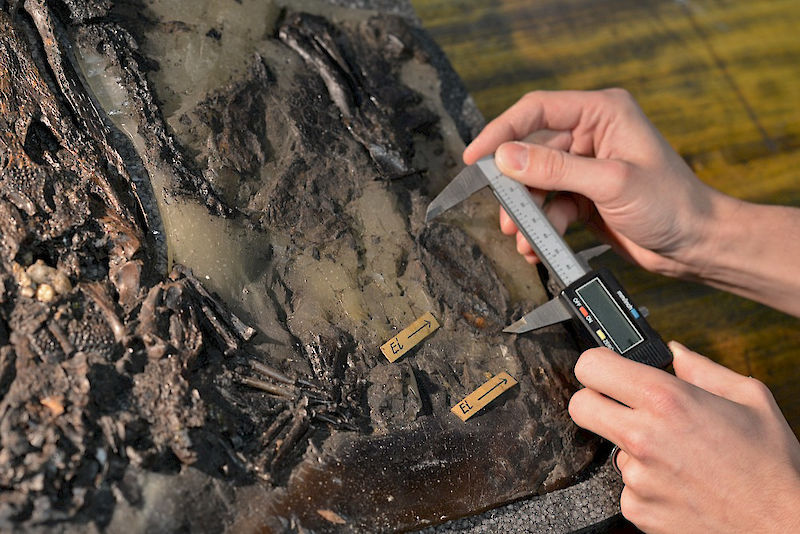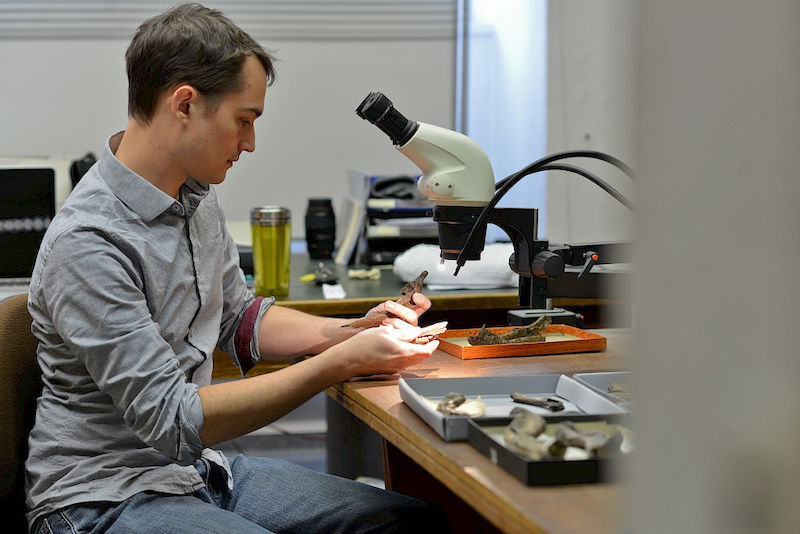News from the past

Dr. Alexander Hastings climbs up a small ladder at his workplace, opens an old, two-metre high cupboard, and carefully pulls out a long, rectangular plate. What appears to a layperson to be a row of bones and other animal remains, reveals, upon closer inspection, the outline of an animal - a small crocodile preserved in paraffin wax and labelled GMH 6074. The animal lived 45 million years ago in the Geisel Valley, just 20 kilometres away. Today, a lake and many layers of soil cover its primeval habitat.
The female crocodile had laid five eggs; however, death came before the eggs could hatch. The animal and her eggs sank into a bog in a subtropical primeval forest and petrified. In 1932, the crocodile remains were dug up by geologists in an area mined for lignite in the Geisel Valley. Hastings has a few theories as to how the reptile died. However, the young palaeontologist is much more interested in knowing whether the find indeed represents a crocodile that is caring for its brood.
According to Hastings, the unusual position of the animal – curled up next to her eggs – is strong evidence of this. It appears that, even in the face of death, the animal kept watch over her eggs. Researchers are still trying to figure out the point at which crocodiles began taking care of their offspring after their eggs had been laid. The Geisel Valley fossil may be central to closing this gap in our knowledge. “Until now, there has been no evidence that crocodiles from the Eocene Epoch cared for their broods. This find is the first of its kind and the only evidence of this,” says the reptile expert. He has come to Halle to study discoveries such as this one.
“I wanted to do research in Europe because palaeontology has its roots here,” Hastings explains. At the same time, the Central Repository of Natural Science Collections (ZNS), home to the Geisel Valley Collection, was looking for an international expert. They wanted a reptile expert who was preferably from a country whose palaeontologists use state-of-the-art methods. “We would like to see more internationally published articles on the Geisel Valley of the Eocene Epoch,” says Dr. Frank Steinheimer, head of ZNS. Alexander Hastings was able to fulfil all of these criteria. The post-doc, who was fascinated by dinosaurs early on as a child, specialises in Eocene fossils. He was a co-discoverer and the first to characterise a giant boa and five new species of crocodile. He has attracted the attention of the scientific community, among other ways, through publication in the journal “Nature”.
Hastings came to Halle in June 2013 for one and a half years as a fellow of the German Federal Cultural Foundation. His stay was extended by six months thanks to follow-up funding. He received an additional 200,000 euros from the Volkswagen Foundation in December 2014 in order to study, characterise and catalogue additional Geisel Valley finds as part of the initiative “Research in Museums”. In the past, the post-doc carried out research at the Florida Museum of Natural History and helped organise exhibits for a wide audience. The contrast between this and his new workplace at the New Residence - which was built in 1531 - couldn’t be greater.
The Geisel Valley Museum closed its doors in 2011 and, since then, exhibits like crocodiles and prehistoric horses have only been on display on special occasions, like the Long Night of Science. The finds continue to be accessible to researchers, however Hastings, preperator Michael Stache and Dr. Meinolf Hellmund, who is custodian of the Geisel Valley Collection, are the only people working on a permanent basis in the rooms of the museum. The first part of an estimated 50,000 fossils will be carefully packed up in a few months’ time and moved to the zoological collection at the ZNS repository, located at Domplatz 4. Here the pieces of the collection will be stored in a proper and safe manner.
Hastings likes to compare the collection to a Sleeping Beauty, who just slumbers on. The collection is undoubtedly valuable. The collection includes over 100 different animal species, including the famous prehistoric horse, that were discovered in the Geisel Valley near Merseburg. An entire era of mammals has been named after these finds. The Geiseltalian in the Middle Eocene, 48 - 40 million years ago, is a term used by palaeontologists around the world.
When geologists from the university dug up the crocodile that Hasting is now studying, they already knew it was a reptile with eggs. However, they didn’t realise the impact their discovery would have. “Back then we were happy with a straightforward characterisation,” says Frank Steinheimer. The fossils were documented in detail in terms of where and in which condition they were found. Hastings explains that today, palaeontologists want to know more specific details. “We want to observe the finds within their surroundings. What did the ecosystem look like in which the animal lived? How did the animal feed itself, what did it eat, and what led to its death?”
The Geisel Valley Collection lends itself particularly well to studying the ecology of the Eocene Epoch. The finds, which are all stored in Halle, represent a period that spans many millions of years making it possible to track changes within the ecosystem. “Such a complete, well-preserved collection from the Eocene Epoch is unrivalled,” he says with the enthusiasm of a specialist who likes nothing more than to meticulously analyse prehistoric bones.
As an undergraduate, PhD student and lecturer at universities in Florida, Georgia and Pennsylvania, the 31-year-old was able to collect knowledge about methodology, which he is now putting to use in Halle. At his workstation, Hastings measures, documents and digitises all of the data his subject of inquiry reveals. Computer-generated 3-D images have been created for the first time thanks to Hastings and specialist preparator Michael Stache. This enables them to be easily compared with other finds in terms of shape and composition. “We are able to determine how certain species gradually adapted to changes in their ecosystem.” The long-term goal is to characterise and enter all of the Geisel Valley fossils into a database – a project that could take decades.
Hastings has carried out important preliminary work with the help of custodian Meinolf Hellmund. He has created a digital map of the places around the female reptile where the fossils were discovered. He has also read about the ecosystem and climate conditions that were prevalent during the period in question in the Geisel Valley, and has examined the influences to which the animal was exposed. He has investigated fossil evidence of brood care and examined the fossil to determine its cause of death. His findings will appear in the journal Palaios in 2015. In his article, Hastings concludes that, in the case of GMH 6074, a drop in temperature was most likely the cause of death. Crocodiles are particularly sensitive to fluctuations in temperature. Because they are cold-blooded animals, a cold climate directly affects their body temperature. “As it got colder, the female apparently tried to maintain the temperature of her eggs for as long as possible,” says Hastings.
The find is only one of many he is currently working on. The palaeontologist is currently writing several papers in which he is trying to unravel the collection’s various mysteries. “One exciting question, for example, is how five different species of crocodile were able to share the same habitat. In modern systems we usually only have one or two – in northern South America possibly three – different species living in the same territory. In this respect, the Geisel Valley is an important exception.” More public awareness for the valuable treasures from Halle will be generated in another way as well. Alexander Hastings and Meinolf Hellmund are currently preparing an exhibition at the Leopoldina in which prehistoric sawtooth crocodiles, giant birds and other animals from the Geisel Valley will be displayed as never before.
As dawn turns to day: horse-hunting crocodiles and giant birds
Starting March 6th, everyone will have the chance to walk through the Geisel Valley of 45 million years ago accompanied by prehistoric horses, sawtooth crocodiles and other extinct species. The ZNS will display the impressive fossils at the Leopoldina in Halle as they have never been seen before. Thanks to computer animation and interactive media, visitors will be able to feel the dynamics of prehistoric life and, through this, learn to understand evolutionary processes. The project has been designed for various age groups; younger children will be able to experience the exhibit at their own level. The bilingual exhibit, financed by the German Federal Cultural Foundation and organised in cooperation with the Leopoldina – National Academy of Sciences, caters to an international audience, scientists and visitors to the region alike.



